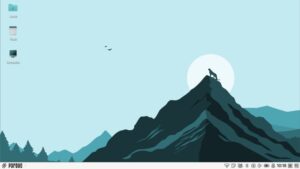Like everybody, we love “five best” lists. Trouble is, how can we come up with a five best list of anything when we haven’t even begun to look at them all? What we can do is list “five favorites,” like we’ve done with this list of five favorite Linux distros.
I’ve never been a distro hopper. Not at all. I started out with Mandrake back around 2002, and stuck with Mandrake/Mandriva until 2010. When it became obvious that the distro was in serious financial dodo and wasn’t likely to be around much longer, I moved to PCLinuxOS. This move was made partly because the distro had started life as a fork of Mandrake/Mandriva, keeping me in familiar territory, but mostly because it was one of two distros I could find that supported the Wi-Fi on an old Dell laptop I was using at the time. In 2012 I moved to Bodhi Linux after falling in love with the simple elegance of the Enlightenment 17 desktop, and the next year switched over to Linux Mint Xfce edition when we finally got around to setting up a full time office for FOSS Force.

In other words, after fourteen years of using GNU/Linux, I’ve only used four distros on anything like a long term basis. You’ll notice they’re all “general purpose” distros. I’m not a tinkerer and I have no need for specialty distros. To me, a computer is something I sit at twelve to fourteen hours daily getting work done, then maybe another couple of hours amusing myself (yup, I need to get a life). For this reason, all the distros I’ve adopted are distros classified as easy-to-use, including light-on-resources Bodhi. I don’t have time to spare getting my system “just like I want it.” I want it to pretty much work out-of-the-box. I want to be able to install the apps I need and take off running.
That being said, I’ve installed and looked at quite a few other distros in my time. That’s one of the things I do — install distros and write reviews about them. However, Distrowatch’s Page Hit Ranking currently lists 277 distros and I seriously doubt that I’ve looked at much more than 10 percent of that number.
This means this list can’t about the five best Linux distros. I haven’t looked at a large enough percentage of the distros available to even pretend to make that list. This is just a list of five distros that I like. Your experience may vary, as Larry Cafiero used to say often on this site.
5. CentOS: Although CentOS can be set up as a desktop distro, I’ve never used it that way. It’s known as a server distro and as a rock solid drop in replacement for RHEL, with Red Hat’s blessing and support. In fact, since 2014, most of the development at CentOS has been done by Red Hat developers working for the company’s independent open source and standards team.
I’ve used CentOS as my server OS of choice since about 2007 when a hosting company I was using switched from RHEL to CentOS. These days, when offered a choice of distros to use while setting up a VPS, I automatically chose CentOS. Why? Because it works, because I have experience using it and because technical support people know and understand it better than any other server distro except Red Hat, which is the same thing. I’m not changing what isn’t broken.
4. PCLinuxOS: As already mentioned, I spent about two years using this as my only desktop distro and developed quite a fondness for it during that time. The distro started life as a fork of Mandrake 9.2 in 2003, and in 2007 took a one time snapshot of the Mandriva source code to develop on its own going forward. This is a rock solid distro with much to commend it.
I’m sometimes reluctant, however, to recommend the distro, especially to new users. Although I haven’t had any interaction with the community’s forums in several years, back when I was using the distro on a regular basis, I found its users to be more than a little on the rude side. Maybe they’ve changed by now, I don’t know.
3. Mageia: This is a distro I really, really like. As with PCLOS, Mageia was born as a Mandriva clone, with many of its developers being old time Mandriva employees. Also like PCLOS, Mageia uses KDE Plasma as its default desktop. Both distros also package apps as RPMs, as parent distro Mandrake began as a fork of Red Hat back when Red Hat was still a shrink wrapped desktop distro. Anyone who ever used Mandrake or Mandriva will be on familiar ground here, as the configuration tools are the old Mandrakesoft tools, only much improved.
The community around this project is also very helpful and super supportive. I never hesitate to recommend this distro to any KDE user looking for a good work distro.
2. Bodhi Linux: I first tried this distro solely because of its name. As a sometimes practicing Buddhist, I couldn’t resist a distro called Bodhi using a minimalist desktop called Enlightenment. These days, the Bodhi developers have left Enlightenment behind for their own desktop, Moksha (which means “enlightenment” in Sanskrit), which is based on Enlightenment 17. The distro’s minimalist approach doesn’t end with its desktop choice. Only a bare minimum apps are installed by default, the philosophy being that the user should decide what apps are needed, not the distro’s developers and maintainers. Don’t think this is a lightweight distro with limited abilities, however. It’s got the full power of Ubuntu under the hood.
The community support forums are also absolutely the most helpful and friendly I have ever found. Although this is admittedly not a distro for everyone, it’s the first I recommend to anyone looking for a full featured but resource sipping distro. The distro even offers a “Legacy” edition for those needing to install on older hardware.
1. Linux Mint Xfce edition: A year ago I would’ve ranked Mint second, just behind Bodhi Linux. However, the longer I’ve used this distro, the more I’ve come to appreciate what Clement Lefebvre and his crew have created. Unlike many other Ubuntu based distros, Mint is such an improvement on it’s upstream source that in my opinion, this is the distro by which other general purpose desktop distros should be measured. In the three years or so I’ve been using it, I’ve yet to find a situation where it didn’t just work out-of-the-box.
I use the Xfce edition because I like the DE, but my recent look at Cinnamon Mint tells me that no matter which desktop edition you choose, you’re still going to get a great user experience. I recommend this distro to everyone from the most experienced Linux user to the totally green newbie.
Christine Hall has been a journalist since 1971. In 2001, she began writing a weekly consumer computer column and started covering Linux and FOSS in 2002 after making the switch to GNU/Linux. Follow her on Twitter: @BrideOfLinux




Pacbang? Manjaro? Antergos?
Bueller?
Anyone?
No love for Debian? 😉 Although it may not be a great distro for beginners, it is what is under the hood for many others.
Of course, I so warped that I run Debian Sid (Unstable) on my desktop and laptop (Debian Stable on servers).
Let’s see:
5) Red Hat.
4) Ubuntu.
3) Debian.
2) Linux Mint.
1) Slackware.
I recommend Mint for most users.
Top five distro I use
1 Manjaro Cinnamon
2 Ubuntu Mate
3 LibreELEC
4 DietPi
5 piCoreplayer
Manjaro is my first choice because it have Cinnamon (and a lot of other desktop native), rolling release, large software availability and tools for make your own spin.
Ubuntu Mate because I have used Ubuntu Precise with gnome-session-fallback for 3 year and a half on 2 pc before switching for a hardware problem (new video card). Remastered with systemback and virtualbox for my friends or older PCs
Before switching from Ubuntu to Manjaro I’ve used Fedora Cinnamon for 1 months, then video driver update messed everything, so tried another distro, also RPM updates and the graphical package manager are so slow compared to those of Ubuntu and Manjaro.
I also like the work of Clement Lefebvre for Mate and Cinnamon but not for the patched Synaptic package manager
The other 3 distros just make their work
My top 5:
1. Debian
Why would I need anything else? It has all the desktop environments I am likely to use.
ARCH Linux, simply the best!
5. Mint
4. Debian
3. Slackware
2. CentOS
1. Fedora
I like to try a lot of distros, but my main machines are almost always running Fedora, been using it for nearly 10 years. Right now I mostly use Fedora MATE, but I also enjoy Xfce and Gnome.
3 Fedora Workstation
2 Debian Sid
1 Arch Linux
That covers more than 80% of Linux history and quality distros.
After reading this article, I decided to give Mageia a spin. Atrocious.
After installation, the only software repository available was the DVD. Attempts to enable other repositories always ended with a message about errors with the repositories.
Not a good first impression.
So another one bites the dust. (So long Mageia)
Currently using Fedora 24 KDE.
My list is pretty simple. It doesn’t even make it to 5!
For my list, I would only choose RPM distros as any of the DEB distros have caused frustration and I find the command line unnecessarily difficult to use in comparison.
So my list goes like this:
Professional Server: Red Hat
Personal Server: CentOS
Home Desktop: Fedora Cinnamon
Honourable mention goes to Linux Mint because they’re the ones building Cinnamon.
Linux Mint Cinnamon
UbuntuStudio
Linux Mint XFCE
Linux Mint Mate
Ubuntu Unity
I used to love Mandrake, Mageia was OK, but I went off the KDE desktop, and haven’t gone back, also I find the Debian based repositories more extensive.
Cinnimon is clean, functional and keeps getting better.
UbuntuStudio, well taht’s my recording studio desktop, basically it’s XFCE
My partner uses Linux Mint XFCE… “a simple desktop for a simple person” is her reason for using it. It also has a few nice things like individual backgrounds for each workspace, that I really like.
Linux Mint Mate it works, it does everything GNOME 2 did
Ubuntu Unity it works, most of the people I’ve helped move to Linux use it without complaint, I can’t ask for much else.
My 5 distro list would go as:
5. Mint Xfce
For beginners looking for a safe and familiar place to start in Linux world.
4. CentOS
For your server.
3. Puppylinux
For very old hardware and rescue system.
2. elementaryOS
For old hardware, for your 60+ family members or anyone that got tired of Windows with low tech/use requirements.
1. Ubuntu
The easiness of unity for your everyday use.
Mageia for me. Used Debian for a while when I was running my own server. No complaints re it. But I’ve been using Mageia for my desktop solution for 4 years now. I’ve never had any problems with software repositories or updates. They’ve always worked flawlessly.
I have tried Bohdi and agree re its quality. Slick DE. Takes a little getting used to, but it is very appealing. Unfortunately, I haven’t had the time to work with it more. It is on my list of things to do.
I prefer Debian myself. Preferably testing or Sid.
But I do help noobs get started and for that I don’t think there is a thing that can beat Mageia.
I am also a big user of the cli. This scares lot of noobs. There is no tool for system management in any OS that is better than the MCC (Mandrake/Mandriva/Mageia Control Center).
I am not a big fan of KDE. Mageia also works very well with Mate (wife runs Mageia with Mate) and Xfce which I prefer.
When you get down to it there is really little difference in distros. They use pretty much the same kernel. They have mostly the same system utilities.
It really boils down to only two things.
A>what package management system you prefer
B>history of maintanence of the system particularly security updates.
Basically all distros are based on foundation (early) distros – Slackware, Debian and Redhat. Some people consider Suse/open Suse to be a branch too. I think the Mandrake fork is a branch simply because it was a fairly radical departure from the Red Hat base.
Add Arch to that list and you have just about every other distro as a respin of one kind or another of one of them.
I prefer to stick with those base distros. There is no layer of added confusion as you get with just about any respin. Due to that you can build the system much easier and faster to be exactly what you want it to be.
Respins do make this easier if you can find one that is close to what you want in the first place. That is where it becomes time consuming because you have to do a lot of distro hopping or just stick with something you grab first.
I introduce people with an external drive I loan out. Usually with 4 DEs all under Debian and roughly configured for ease of use (in my opinion) and therefore they really could each qualify as a respin. So I really can’t be throwing stones very hard at respins.
This sort of list is handy. People can read them and maybe get a different point of view as to what they want to try.
This is Gnu/Linux. It is your box. It is your choice. Your choice of a distro and DE is absolutely perfect. For you at the time you choose it.
The important thing to remember, under any OS, is that you never, ever loose important data in a system failure. You can tell any data you lost was not important. Because it wasn’t important enough to backup. If it was you would have backed it up.
I tried almost every distribution since 1998 and for recent years I used Mint & Ubuntu releases. I decided to try recent releases of major distributions before 5 months ago. Stability, package management, resource usage of Slackware & Debian & Centos are far better than any other distribution.
My favorite is Slackware with KDE Desktop
1 – Slackware
2 – Debian
3 – Centos
4 – Mint
5 – Ubuntu
I’m an avid Linux user. Arch – is a beast to install. I’m not a glutton for punishment. These days – I only tinker with the Larger Main “big boys” OpenSuse, Fedora, Mint, Debian, ….. Haven’t touched Slackware in 10 years. Why bother. Only tinker with the smaller independent distributions in a VM environment. I like things that JUST WORK….. out of the box. I hate it when the upgrades – trash and break things. Not too often with the likes of Mint / or OpenSuse….
I hesitate to give a list of my five favorites, especially in any particular order. When I started putting Linux on my personal computer(s), it was Linux Mandrake 6.0 that I used first. When I left that, I used Slackware (with either Fluxbox, IceWM, or Xfce)for quite some time, though I maintained a Debian box at work during this time also. When I got too lazy for Slackware, I looked around and ended up zeroing in on Ubuntu Studio (which I would switch over to Xfce (or Fluxbox or IceWM) from the default Gnome desktop, before Unity’s introduction and the distribution’s general switch to Xfce).
These days I use a mix of distributions for things, many Ubuntu based. On my personal desktop and main laptop, I still have Ubuntu Studio. Sometimes I will put Xubuntu on machines I prepare for others. I tend to put Lubuntu on more limited resource machines, especially if they are low powered 64 bit machines. On machines that are even lower resource, I tend to put Debian or Salix Fluxbox (Salix is fun for someone who used to use Slackware for everything, but is too lazy to maintain it now). I tend to use Debian for servers (though you may catch me using Slackware at times).
I have used CentOS a little at work, but not very much really. I ran into an issue when I went to try Manjaro a couple of years ago, but I’ve been meaning to take another look at it, which I will probably do soon. When I looked at Mint, there was no smooth upgrade path without a reinstall, so I dropped it (I’m not sure if that’s still true). There are a number of other distributions I’ve tried, but far from all that are available.
I use OpenSUSE as my primary OS, so I guess that’s #1.
I use GalliumOS on my laptop, so that’d be #2.
Given that GalliumOS is just Xubuntu with some Chromebook/Chromebox compatibility fixes, you could make a good case that Xubuntu is #3. (Or tied for #2, or however you want to interpret that.)
I keep a Debian/Xfce boot onhand in case I ever have issues with OpenSUSE. So let’s call that #4.
I’ve also got a desktop running Ubuntu Studio, but I’ve never really gotten it working right. (I couldn’t make heads or tails of Jack.) But given that it’s yet another Xubuntu derivative, that’s probably another point for Xubuntu.
I used Slackware for a few years, and then Gentoo. I learned a lot but ultimately found both of them to be far too fiddly. I used to enjoy tinkering under the hood; now it feels more like a chore and I’d rather use an OS that doesn’t need so much of it.
I used Kubuntu for a number of years, but it’s been a long time since KDE was even the second priority for Ubuntu devs. Now it’s, what, sixth?
I don’t like GNOME 3. Unity is serviceable but I’m not crazy about it either. Cinnamon and MATE are better, but I don’t like them as much as Xfce or KDE.
I use ArchLinux as base for my Gnome or KDE desktop, works fine with both.
Since I started with Linux in 1998 I tried many Distros…and always came back to openSUSE.
First, because I like KDE
Second, YaST for system management is unmatched for end-users
and third, the build environment with OBS, openQA, Studio and more is unmatched in terms of ease-of-use and quality.
The distro itself – based on the commercial SLE – is rock solid and offers all kinds of Desktops, if you dont fancy KDE.
I agree with your list. The article was poor and bias.
@Max: I have no idea who you’re talking to when you say “I agree with your list.” As far as “bias” in the article, well, it’s someone’s personal opinion, and doesn’t pretend to be anything else. You’re welcome to disagree and share your own thoughts.
@Thad Max’s post looks like comment spam to me, there is probly supposed to be a link there as well, which I suspect is being filtered out.
Yeah, I realized that after I posted. Guess it got me. Presumably it’s designed to look for keywords like “list”.
1-Manjaro
2-Mint
3-openSUSE
I found strange that you say the community in PCLinuxOS is rude I’m a 9 years member and what kept me there was the community.
I must add that I’m not a programmer, just a regular folk in an office with a very demanding work and PCLinuxOS has never let me down in all those years, is rock solid.
In the time I’ve used it I’ve seen a lot of new comers thank the fellows that help them.
Before that I distro hopped a lot and it was the first place where the lead developer answered question from people like me that knew almost nothing, later I realized that my questions were too basic but they were patient.
So you wrote the article and are entitled to your opinion, I say new comers are welcomed, try the community and check for yourselves.
I’m a very short time PCLinuxOS user but I have to agree with Crow, the community there have been both friendly and welcoming.
GNU/Linux itself is fairly new to me (about a year) The first distro I tried was Lubuntu and I liked it … until I asked a ‘noob’ question in the Ubuntu forum and was roundly criticized and admonished. Never went back nor did I ever boot Lubuntu again, I went back to Windows while I searched distro forums for a compatible match (I decided a friendly forum is a must for any distro I’m gonna try.)
My favourites are based on ease of installation and use for a Linux beginner … and of course a friendly community
1) PCLinuxOS – it works OOB, has some great bonus’ you don’t get with other distros.
2) Mint – (any flavour except LMDE, haven’t tried that yet) it just works and has a large helpful community.
3) Lubuntu (I liked the distro … hated the community)
For older hardware (single core, 32bit, low RAM)
4) Q4OS – runs my old hardware very fast
5) Linux Lite – my technically challenged wife uses it everyday without any issue.